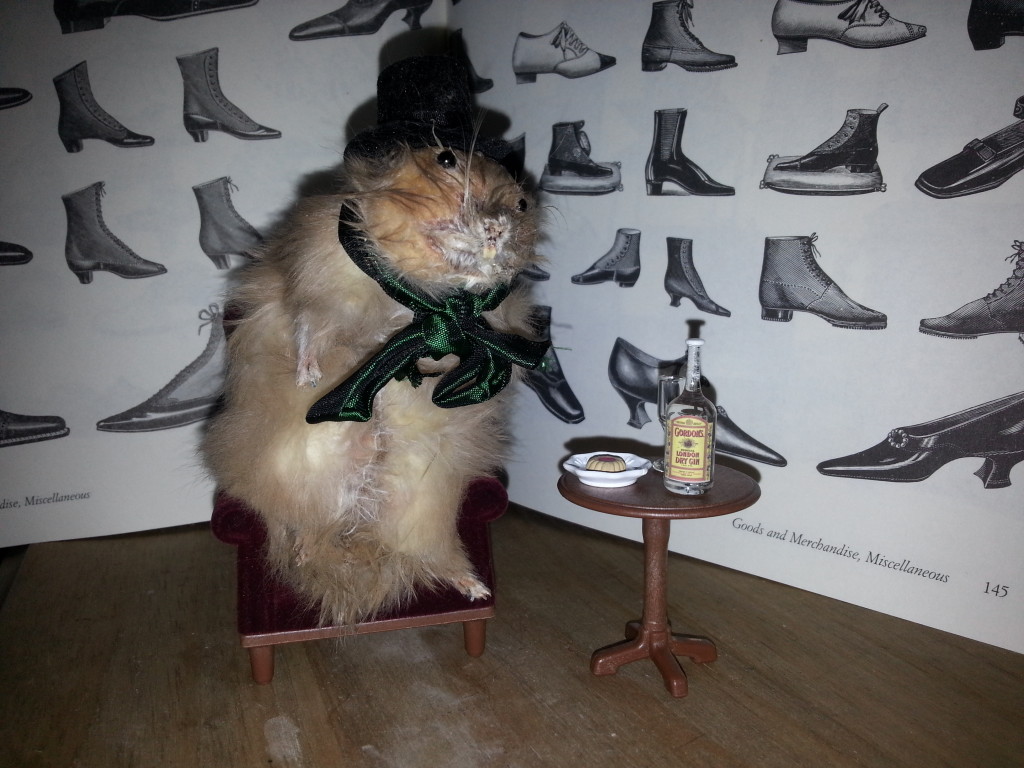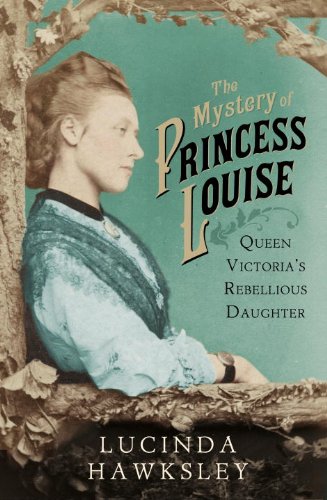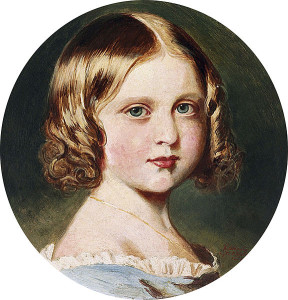I’m on Literary Rejections, talking about my experience of the agent querying process.
Verity gets a hamster. Kind of.
I always thought I had no crafting talents. Friendship bracelets, daisy chains, iced cupcakes – all a total loss. Turns out, I’m alright at taxidermy.
As a child, I was hugely upset by stuffed animals. I seem to remember it stemming from the conviction that a squirrel would appreciate a proper Christian burial. As I got older, however, seeing the anthropomorphic work of Walter Potter and taking an interest in human mortuary customs and anatomy as a science, I began to develop a fascination. Plus, an exceptionally large pigeon once dropped dead out of a tree and into my garden, and as I shooed the dog away I found myself thinking, “I should really do something with this…”
So we booked our places at one of The Last Tuesday Society‘s anthropomorphic taxidermy classes. If you’re at all Fortean in nature, you must get down to Hackney and see this place. I felt like I’d found my tribe.
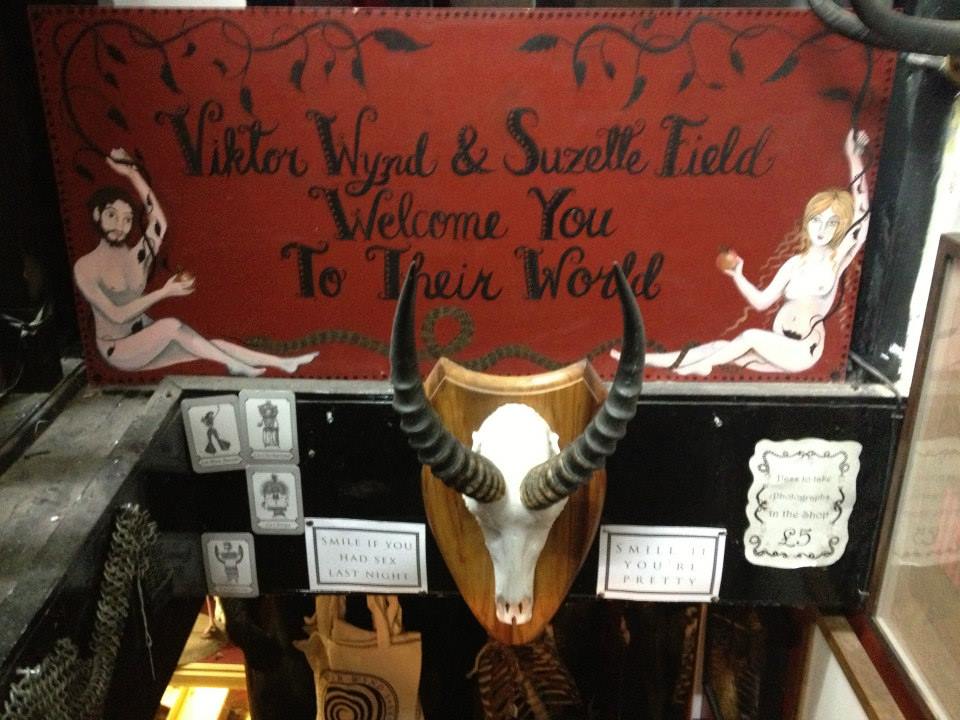

It probably helped that I’d never had a pet hamster.
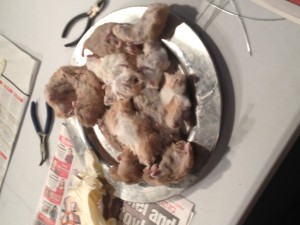
All our hamsters were the unsold snake food variety, destined to otherwise go in the bin. It’s important to most modern taxidermists that their animals are not killed especially for stuffing, and instead rely on roadkill, stillborns, and the like. There are surprisingly numerous vegetarian taxidermists, our instructor Michelle included. The omnivorous variety often consume the more edible animals, and Michelle feeds her leftover meat to her pet axolotl.
I’ll admit, I felt some trepidation as I wielded the scalpel for the first time. It didn’t help that my instrument was blunt, so, when given a sharper blade, I punctured the inner cavity and learnt a sudden exciting lesson about intestines.
If, unlike me, you’re a natural skinner of rodents, you should never see the inner cavity. There’s very little risk of flying gore. You more or less de-glove the hamster, taking care around the eyes, clip the feet, clean the skin, pop a cotton wool mould inside, and sew it up. Ours took about five hours while the room gradually began to smell like an upmarket charcuterie.
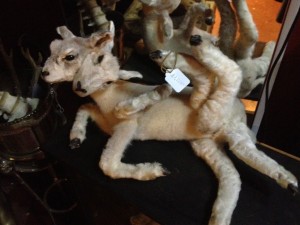
Downstairs, in Viktor Wind’s Little Shop of Horrors, we saw how the professionals do it.
It will sound strange to anyone naturally repulsed by taxidermy, but being so hands on with a dead creature actually increases your feelings of respect. You get a fantastic sense of the wonder of anatomy; milky little hamster ribs perfectly encased in tight, pink flesh. And then you get to put a hat on it!
My effort:
Burlington Bertie, he’ll rise at ten-thirty, and saunter along like a toff
He walks down the Strand with his gloves on his hands
And saunters back down with ’em off.
And Gabriel’s:
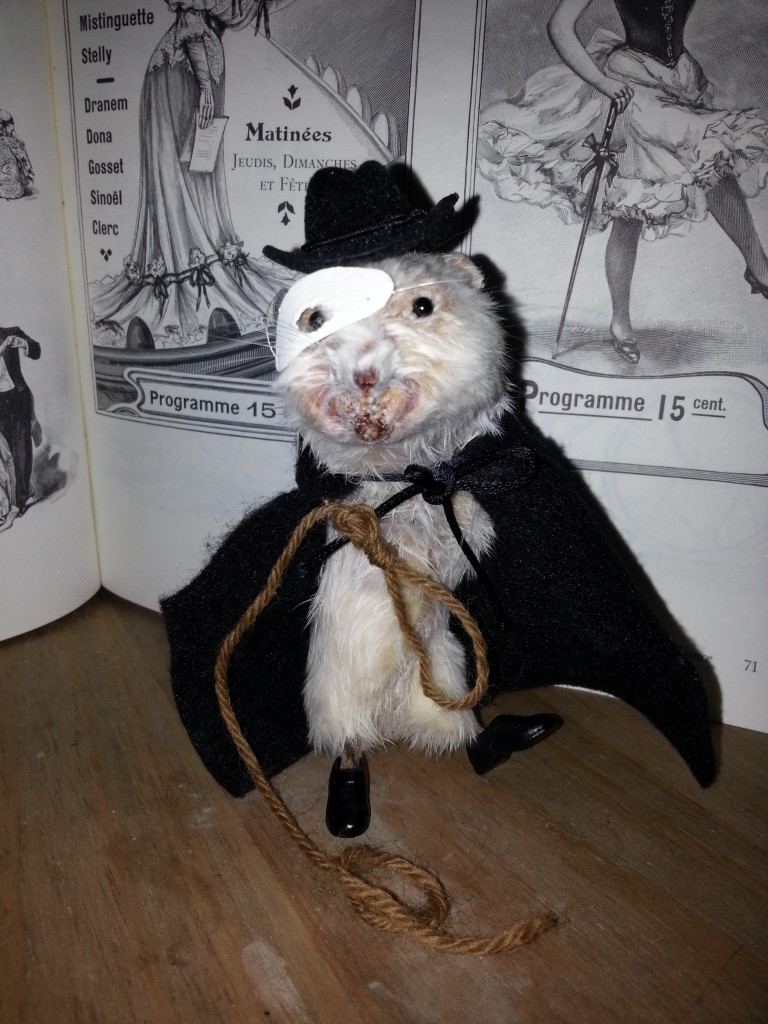 He’s here! The hamster of the opera.
He’s here! The hamster of the opera.
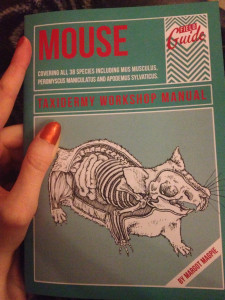 I think I was always destined to become that odd woman with a bin bag, scouring roadsides. At least now I’ll have a purpose.
I think I was always destined to become that odd woman with a bin bag, scouring roadsides. At least now I’ll have a purpose.
For more anthropomorphic taxidermy, see Margot Magpie’s Of Corpse Taxidermy (or indeed her Taxidermy Workshop Manual, which we bought for future adventures), and Amanda’s Autopsies. For some crappy taxidermy, head to…Crappy Taxidermy.
Hilarious antique find of the day: John Ruskin brand cigars
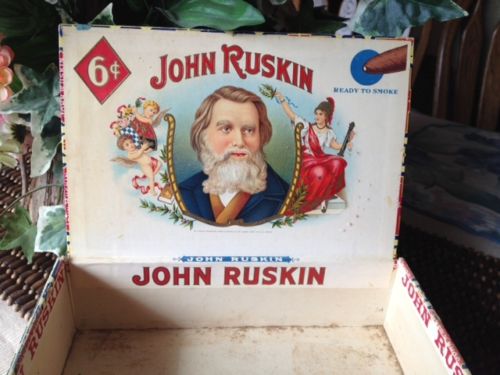 John Ruskin, rosy cheeked and inundated by cherubs, as he was in life.
John Ruskin, rosy cheeked and inundated by cherubs, as he was in life.
 Best and biggest! Perfecto extra!
Best and biggest! Perfecto extra!
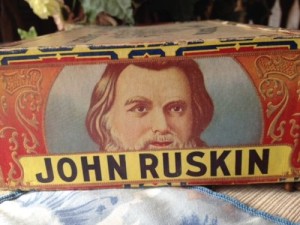
Look at that face. That’s a man who knows he’s perfecto extra.
The Mystery of Princess Louise: Queen Victoria’s Rebellious Daughter
With her latest book, Lucinda Hawksley delves where the monarchy would rather she didn’t.
The life of Princess Louise is one clouded by rumours and misdirection. Queen Victoria’s fourth daughter was said to be simultaneously difficult and charming, dense and witty, beautiful and naughty. With her files still closed to researchers and the public alike, getting a good look at this headstrong woman is a challenging task, fraught with dead ends and muffled hints of scandal. Hawksley’s new biography is the closest we’ve yet come to the true face of ‘Loosy’.
“Luckily the habit of moulding children to the same pattern has gone out of fashion. It was deplorable. I know, because I suffered from it. Nowadays individuality and one’s own capabilities are recognised.” – Princess Louise in a newspaper interview from 1918.
Individuality and independence were luxuries Louise refused to take for granted, likely because Queen Victoria’s treatment of her children was toe-curlingly cruel. The Queen frequently communicated through notes delivered by servants (even when the child at fault was sitting beside her) and laced every affectionate statement with a critical undercurrent. Even when they flew the nest, Victoria would do her best to interfere in her children’s lives to a stifling degree. The psychological effects make for heart-rending reading. When Louise’s father, Prince Albert, died, the thirteen-year-old cried out, “Oh, why did not God take me? I am so stupid and useless.”
It is not surprising that Louise strove to be the polar opposite of her overbearing mother. While the Queen deplored the concept of equal rights for women, Louise admired the drive and ambition of Florence Nightingale and Mary Seacole. The Queen adored Scotland – Louise craved sunshine. The Queen was a stickler for propriety, but Louise, who took on many of Victoria’s official duties during her long mourning for Albert, would openly remark her mother simply couldn’t be bothered any more. The Princess’ charismatic disregard for protocol made her charming, yet her mother seemed set on the idea that Louise was had learning disabilities, or was, as she put it, “naughty and backwards”. Most likely, the artistic young woman was bored.
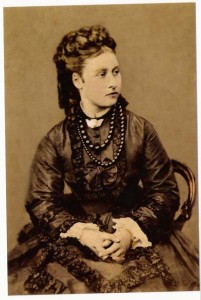
Louise, with Pre-Raphaelite accessories.
This frustration found release in the hard physical work of sculpture. Although William Michael Rossetti took a public swipe at her, tartly (but also quite rightly) stating that an artist who happens to be a royal cannot be judged on merit alone, Louise was genuinely a talented and thoughtful sculptor. She befriended a number of the Pre-Raphaelites (though Dante Gabriel Rossetti was out when she called) and adopted their sense of style, moving in Aesthete circles among radical thinkers, to the horror of her class-conscious mother.
The biography sensitively charts the ups and downs of Louise’s unconventional marriage to the homosexual Marquess of Lorne, a man she came to detest, and later to platonically respect. Rumour had it, the Princess knew Lorne picked up soldiers in the park near their apartments. She consequently had the windows facing them bricked up. More shockingly, Louise herself had a number of affairs. This, Hawksley surmises, is why her files are so forcefully concealed to this day. Although her brother Bertie was a famous philanderer, and even Queen Victoria enjoyed a healthy sex life, there are indications that before meeting Lorne, Louise had done the unforgivable and been an unwed teenage mother – via her brother’s tutor. How Louise concealed this alleged pregnancy – and what may have happened to the child – provides a fascinating insight into the Victorian double standards of gender and sexuality, and also Louise’s indomitable spirit.
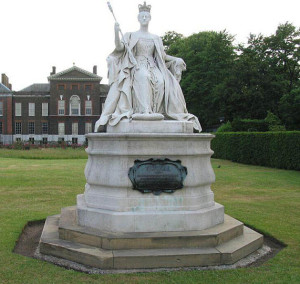
Louise’s statue of her mother at Kensington.
The scandals don’t stop there. Louise was at ease in the company of men, and therefore attracted a great many admirers, including the artist Sir Edgar Boehm. Despite efforts to wipe the affair from the record, it would seem Boehm died during sex with Louise, leading to comical rumours that the body had been rolled up in a carpet and bundled into a cab to avoid a scandal. That Louise continued to be a vivacious, fun-loving woman after this and other such traumatising events is testament to the inner strength forged by years of her mother’s bullying.
But the book is much more than a catalogue of naughtiness. Far some being yet another fawning royal biography, Hawksley’s The Mystery of Princess Louise is unflinching about the human flaws of her subjects. Hawksley conjures the nineteenth century in an accessible way, showing the royal family as being an active part of the great Victorian machine rather than simply perching in its upper echelons. She regularly brings up the contemporary republican viewpoint, which may surprise and interest readers. The same arguments are debated today.
Hawksley also brings up a very important point: Queen Victoria’s diaries as we know them now are the product of heavy editing by ‘the arch-inquisitor’ Princess Beatrice. We will never know her stronger comments on Louise’s liberal lifestyle or the lengths she went to to conceal her daughter’s teenage misdemeanours. In the mid-twentieth century, Princess Margaret made an attempt to research the Princess Louise – even she was barred from the most sensitive records. What we do have is the testament of the companions, servants and chance encounters Louise had during her long life; people who found Louise to be an engaging, headstrong, charming, and exceedingly modern artist and princess.
Lucinda Hawksley’s The Mystery of Princess Louise: Queen Victoria’s Rebellious Daughter is out on the 21st of November 2013.
BBC News: “Winds of 80mph are expected to sweep across the East of England today in what could be the worst storm in 30 years…”
Brain: “Wear the big floaty skirt.”
Me: “What?”
Brain: “Wear it. The big floaty skirt. Wear it outside.”
Me: “In 80mph winds?”
Brain: “Floaty.”
Me: “But -”
Brain: “Wear the big floaty skirt.”
…
I am wearing the big floaty skirt.
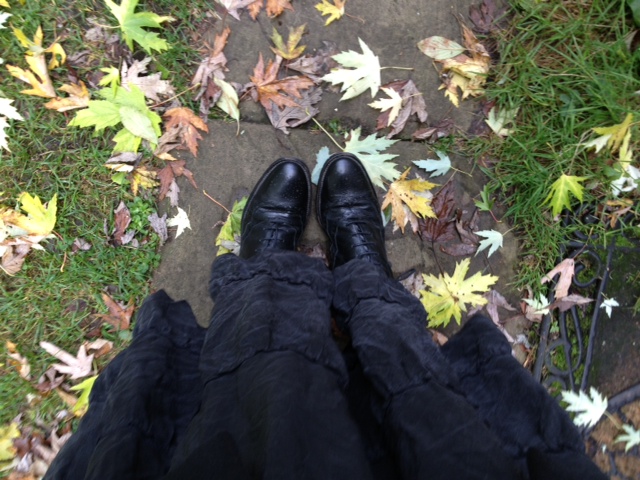
I just learned that A.C. Crispin died of cancer last month.
I feel ashamed to learn this belatedly. Earlier today, I’d been raving about her Han Solo trilogy, how they excited me as a young reader, how they shaped my tastes and aspirations.
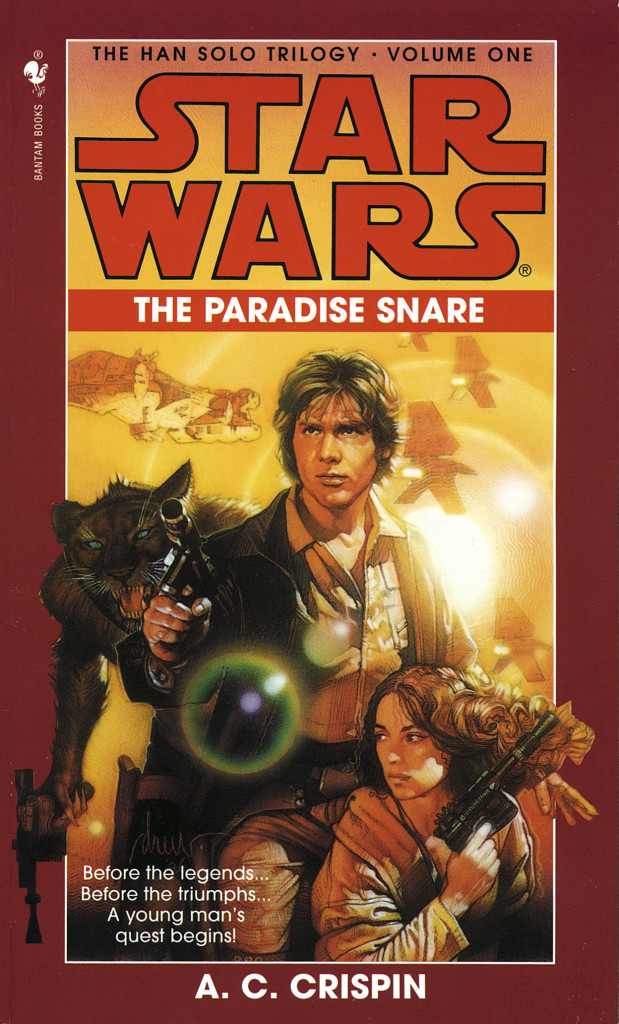 I was a nerdy sci-fi-loving pre-teen when I found The Paradise Snare in – I think – London’s Science Museum, back when a £4.99 paperback presented a considerable investment for your weekly 50p pocket money. A vivid memory: standing on the Circle line, a plastic carrier bag swaying on my wrist, unable to shut this book.
I was a nerdy sci-fi-loving pre-teen when I found The Paradise Snare in – I think – London’s Science Museum, back when a £4.99 paperback presented a considerable investment for your weekly 50p pocket money. A vivid memory: standing on the Circle line, a plastic carrier bag swaying on my wrist, unable to shut this book.
Here were gunfights, aliens, drug-fuelled religious cults and a love story with teeth. It was funny and dangerous and probably not appropriate for a child, but when these things are smuggled in genre fiction they end up in kids’ bedrooms, and why not?
My Star Wars obsession was the kind of love you can only sustain during the 12-16 age gap. When you lived in Suffolk, never more than six feet from a tractor, escapism wasn’t so much a pastime as an essential coping mechanism, and I must have read and re-read those books scores of times. I may even have loved them – whisper it – more than the films.
Unlike Brian Daley’s high-camp Solo novels published in the ’70s (featuring a droid called Bollux – oh dear), Crispin peeled back the swashbuckling to provide a compelling, surprising backstory for this character who started off as a wisecracking space cowboy played by a painter and decorator. “You can write this shit, George, but you sure as Hell can’t say it”.
This was pre-Internet, at least in my house. I didn’t know who A.C. Crispin was, let alone whether this was a man or a woman. I only knew this was someone whose imagination excited me, and perhaps that’s how it ought to be.
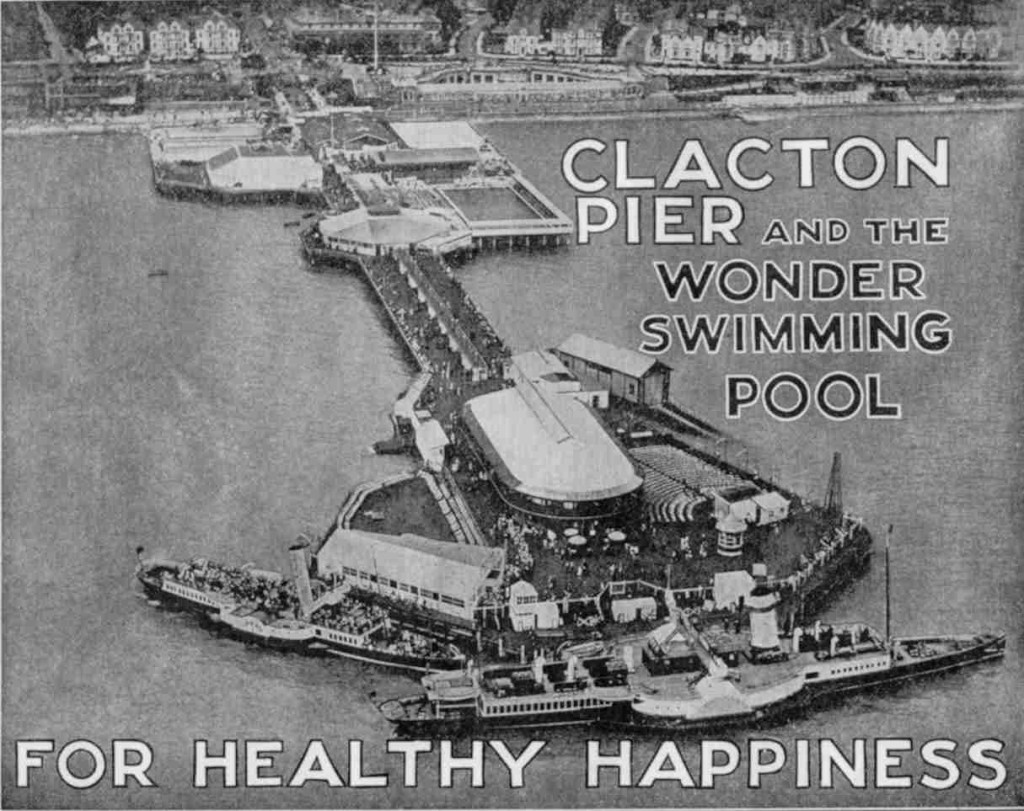
The bacta tank – for healthy happiness
It’s hard to imagine now, but in 1997, if you wanted to even begin to experience the kind of shared fandom excitement you take for granted now on Tumblr, you had to get someone’s dad to drive you to a seaside shack in Clacton for the delight of being breathed on by lonely men in all-too-form-fitting Starfleet uniforms. (Actual experience, let’s not dwell on it). Fan fiction was something you stored on a floppy disc and kept to yourself. In the acknowledgements of the final book in the trilogy, Rebel Dawn, Crispin thanked ‘The Star Ladies and all my on-line friends’. Whoa. There were people online like me? Female people? Who get thanked by authors?
I’d been putting together little handwritten books since I was small, but reading Ann Carol Crispin’s Star Wars tie-ins made twelve-year-old me realise the adventures in your head were something you could write down for other people and therefor make real. All these years later, I haven’t forgotten how her books made me feel. And I’ve never stopped writing.
National Poetry Day – Insomnia by Dante Gabriel Rossetti
Anyone who’s experienced long periods of sleeplessness knows it’s Hell. Insomnia dogged Dante Gabriel Rossetti most of his life. When he was well, he’d often work until dawn and sleep during the day. When he was ill in the 1860s and ’70s, sleep evaded him completely, turing him onto sedative drugs and stiff doses of whisky – bad news for a man who’d been almost teetotal most of his life.
Written in 1881, a year before his death, Insomnia was one of Rossetti’s last poems. With its lulling, almost seasick rhythm and disordered sense of time, I think the poem captures the way in which sleeplessness dulls and heightens the senses simultaneously, trapping the sleepless one in a purgatorial state of memory, desire, and regret.
Insomnia
Thin are the night-skirts left behind
By daybreak hours that onward creep,
And thin, alas! the shred of sleep
That wavers with the spirit’s wind:
But in half-dreams that shift and roll
And still remember and forget,
My soul this hour has drawn your soul
A little nearer yet.
Our lives, most dear, are never near,
Our thoughts are never far apart,
Though all that draws us heart to heart
Seems fainter now and now more clear.
To-night Love claims his full control,
And with desire and with regret
My soul this hour has drawn your soul
A little nearer yet.
Is there a home where heavy earth
Melts to bright air that breathes no pain,
Where water leaves no thirst again
And springing fire is Love’s new birth?
If faith long bound to one true goal
May there at length its hope beget,
My soul that hour shall draw your soul
For ever nearer yet.
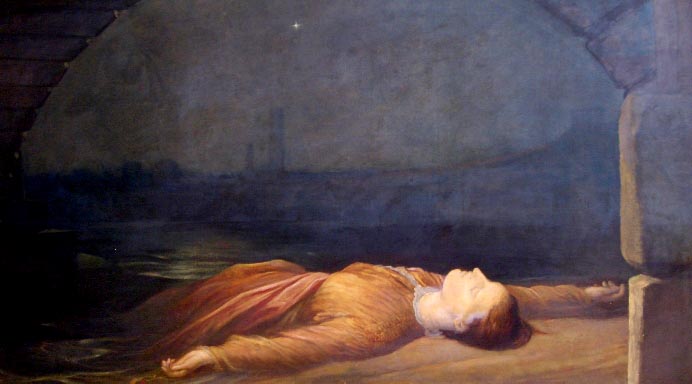
Found Drowned – George Frederick Watts
Henry Darger and The Realms of The Unreal
To most who encountered him, Henry Darger was a quiet little man in an army overcoat. He lived alone in a one-room Chicago apartment, attended Mass daily, and swept the floors of the local hospital.
The old man appeared to have no family, no friends, and accepted help only from a select few neighbours who couldn’t agree on how to pronounce his name. But in the early 1970s, when Henry Darger became too frail to care for himself, his astonishing inner world was finally uncovered.
In his tiny apartment, Henry left an autobiography, hundreds of visionary paintings, and perhaps the world’s longest novel – over 15,000 pages. His landlords were astonished, and took the decision to preserve Henry’s room and its extraordinary contents. He is now considered one of the twentieth century’s greatest outsider artists.
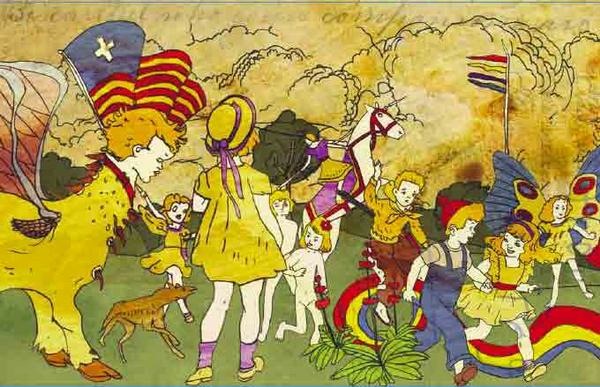
With no artistic training, the reclusive Henry had taught himself how to trace, colour and enlarge the vast collection of ephemera he amassed since the early 1900s, turning sweet Americana into what he called The Realms of The Unreal. Violent, funny, optimistic and fatalistic at once, his is a world in which children live under the constant threat of evil, where little girls are as brave as grown men, and where supernatural creatures live to protect children – and often fail.
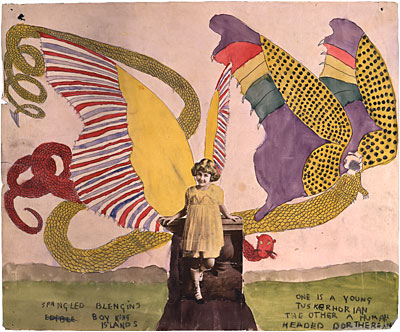
So what was Henry like as a child? His story is an unhappy one. Born in 1892, Henry was a socially-awkward little boy, pushed from institution to institution in an age when children with learning disabilities were even more vulnerable than they are today. Orphaned early, he saw how children fared in such environments without a caring adult hand.
“Never had a good Christmas in all my life, nor a good New Year. And now, resenting it, I am very bitter. But, fortunately, not revengeful.”
In his autobiography, Henry talks about a time he was lashed by the wrists to the back of a galloping horse as punishment for an escape attempt. Many of his artworks linger on the act of strangulation.
Henry went on to serve in the First World War. Though he never saw active combat, the military experience stayed with him, increasing the vividity of the imaginary conflict he called The Glandeco-Angelinian War Storm between the Christian nation of Abbieannia and the vicious Glandelinians who kidnapped and collected child slaves. In these fictional battles, Henry had the chance to fight back.
“One remarkable incident during the battle when heaven and earth seemed to be going to pieces was the bravery of General Darger. “The cowards! To pursue innocent children with that big number,” snarled Darger in a boiling rage. “I won’t spare a man.” Then he gave the signal to his men to blaze away.”
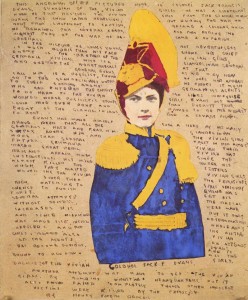
Henry wrote two endings to his epic: one in which the Abbieannian Christians save the children, and another in which evil triumphs.
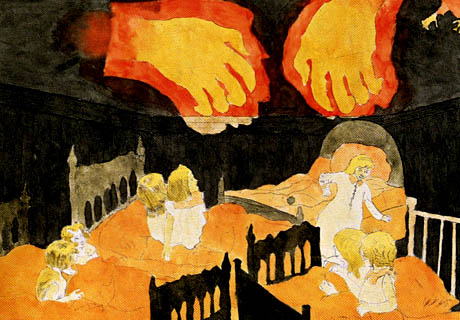
In terms of imagination and detail, The Realms of The Unreal reminds me of Pauline Parker and Juliet Hulme’s Fourth World, and the Brontë siblings’ Angria and Gondal. Interestingly, these private worlds featured the authors as deus ex machina called ‘genii’. Henry wrote himself into The Realms of The Unreal as the leader of ‘the gemini’, the elite protectors of children.
 In reality, Henry longed for a child of his own. He petitioned the Catholic church to allow him to adopt, but his request was repeatedly refused. Henry didn’t have the $5 a month it would take to look after a dog.
In reality, Henry longed for a child of his own. He petitioned the Catholic church to allow him to adopt, but his request was repeatedly refused. Henry didn’t have the $5 a month it would take to look after a dog.
After being taken from his home to the infirmary, the elderly Henry faded fast. His neighbours clubbed together to clean his apartment, whereupon they unearthed a life’s worth of work. No one had suspected the quiet man capable of such far-reaching vision and tenacity. Henry’s reaction to the discovery of his secret world: “Too late now.” He died on April the 13th, 1973.
If you take one thing away from the Henry Darger story, it’s the importance of creation. It doesn’t matter if you can’t draw to prize-winning standard, it doesn’t matter if your spelling is atrocious or you haven’t read the canon of Western literature. If you have something inside you, get it out. Let it flourish on your terms. As Rossetti said, it’s “fundamental brainwork”, not “academic frippery”, that wins in the end.
There is a touching documentary on Henry Darger by Oscar winner Jessica Yu, with music by one of my favourite composers, Jeff Beal. You can currently see the whole thing on Youtube:
Wend It Like William – The Morris Pilgrimage with Curiocity
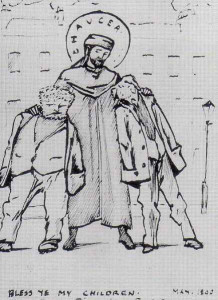 Whilst fully admitting it feels as if I left both my legs somewhere in Greenwich, this weekend’s Curiocity Pre-Raphaelite Pilgrimage was a great (and exhausting, oh good God, exhausting) way to spend a Saturday.
Whilst fully admitting it feels as if I left both my legs somewhere in Greenwich, this weekend’s Curiocity Pre-Raphaelite Pilgrimage was a great (and exhausting, oh good God, exhausting) way to spend a Saturday.
Beginning at Southwark at The George Inn, an original coaching inn close to the site where Chaucer’s Canterbury pilgrims would have set off, we embarked on a thirteen mile trek to William Morris’ Red House in Bexleyheath, an ‘escape from the city’ taking in the green spaces and lesser-travelled highways of the London Morris would have known.
Coffee in hand, we were packed off with a retelling of The Wife of Bath and the encouragement to tell stories and mingle along the way.
In th’ olde dayes of the Kyng Arthour,
Of which that Britons speken greet honour,
Al was this land fulfild of fayerye.
The elf-queene, with hir joly compaignye,
Daunced ful ofte in many a grene mede.
This was the olde opinion, as I rede;
I speke of manye hundred yeres ago.
But now kan no man se none elves mo
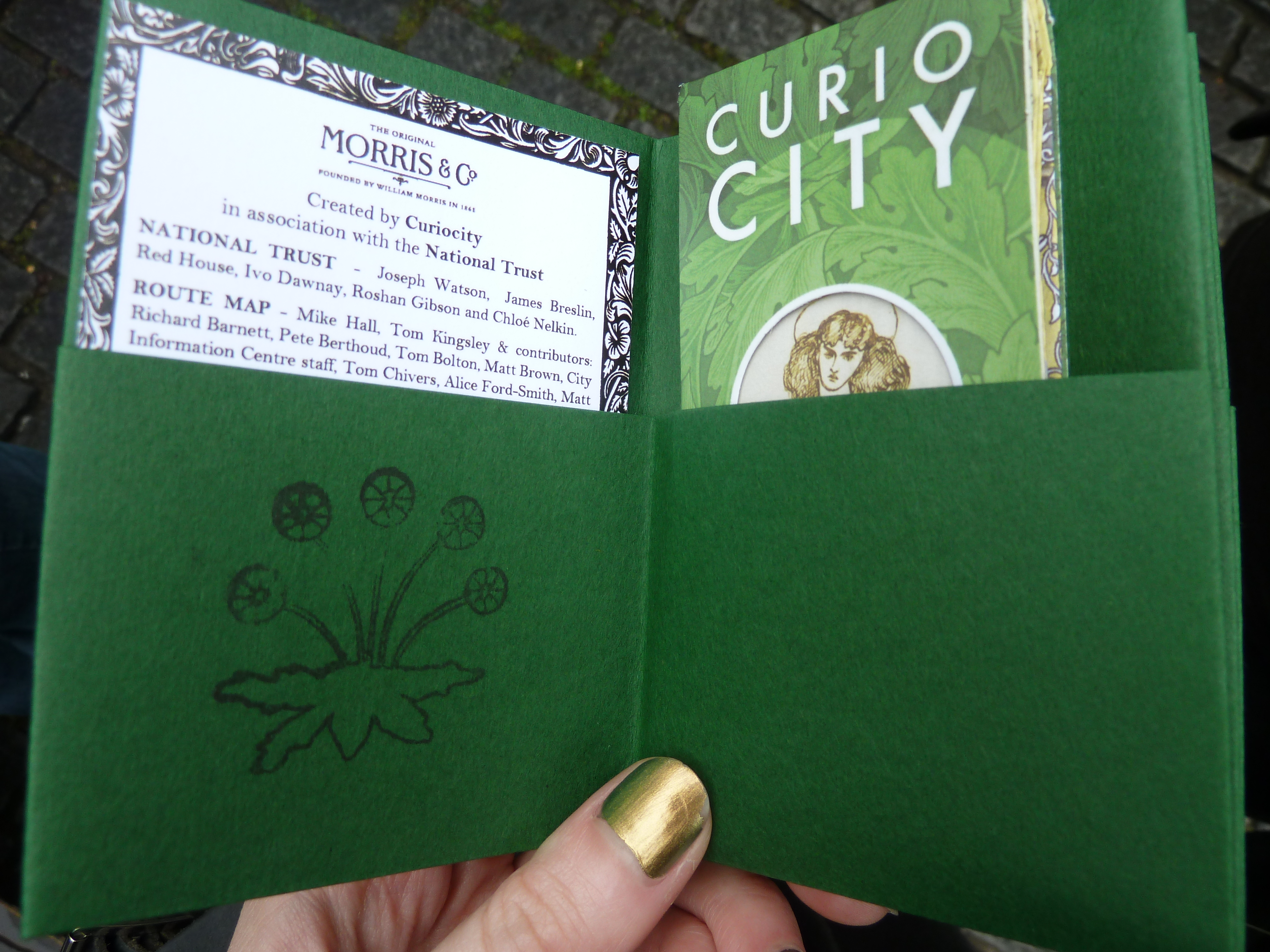
The Pilgrim’s Passport
We wended our way across the city, thanks to chips and cider, a lot of laughter, and some wonderful sights on the way: the grave of Christopher Marlowe in Deptford (topped with a fresh-cut red rose), storytelling in the Queen’s Orchard following a sudden rainstorm, and seeing the brown guts of the Thames bared at low tide, where the mudlarks and toshers would once have rooted for valuables – the modernity Morris sought to flee, and the history that made up the landscape of his imagination.
(This got me thinking. An equivalent Rossetti pilgrimage might involve a nocturnal wander through Chelsea, the ransacking of a Whitechapel antique shop, and a good cry on the floor. Another Saturday, perhaps.)
Back at Red House in time for folk music and a further dose of cider, we had our polaroids taken by the front door as proof of survival. Yes, we all brought wombats. We are serious scholars.
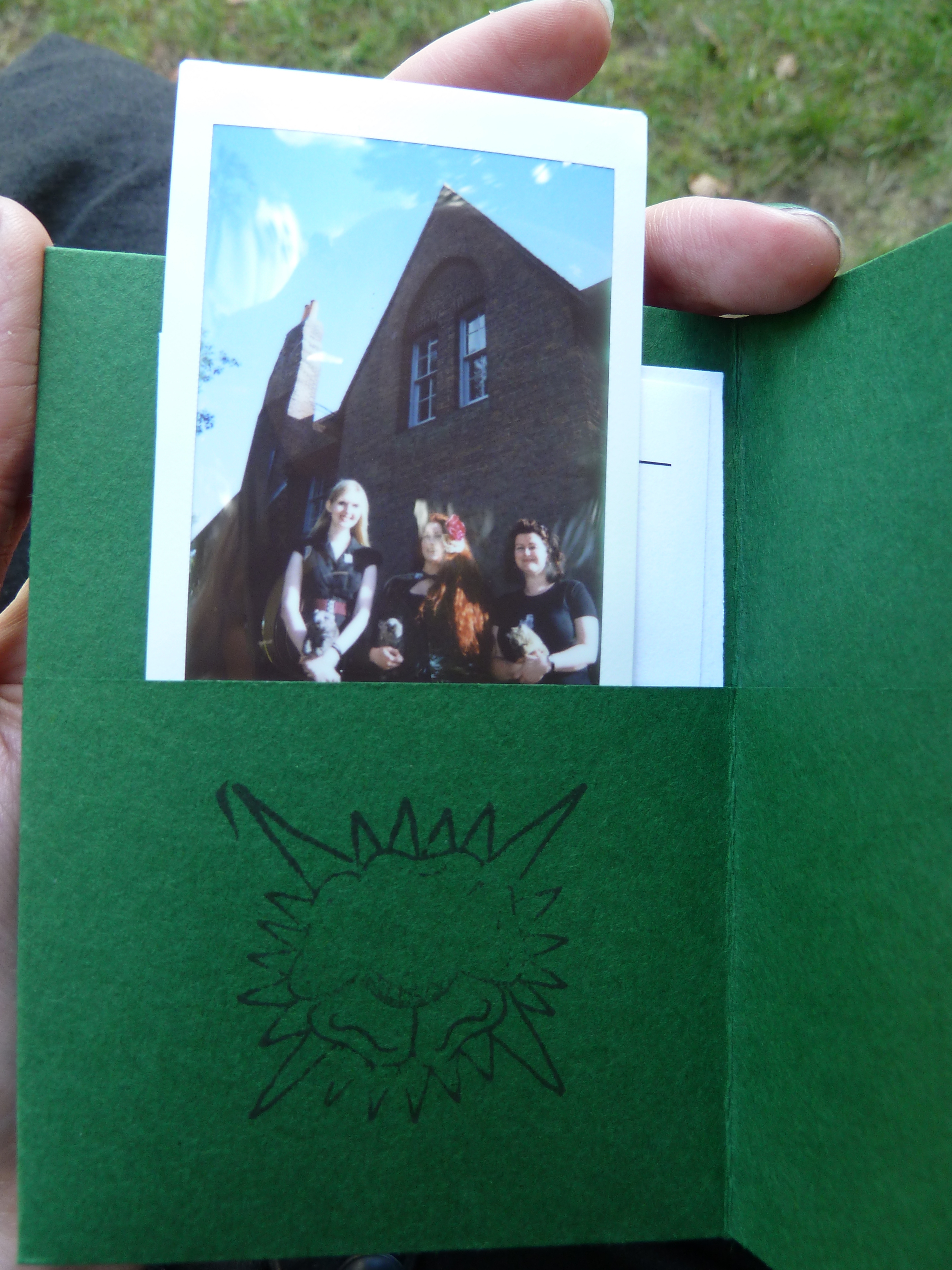 At the same time, across London, 300 people were arrested at an EDL rally. We were reminded that for every person generating cruelty and ugliness there is more than one devoted to beauty and equality.
At the same time, across London, 300 people were arrested at an EDL rally. We were reminded that for every person generating cruelty and ugliness there is more than one devoted to beauty and equality.
“All we true people must make up our minds – if we don’t see – to feel each other – & never let go. Else the wicked ones will have it all their way.” – John Ruskin
Seeing those newly-uncovered murals for the first time was as exciting as we knew it would be. There’s what could well be Morris’ first repeating floral pattern, as well as two wombats (verified by John Simon, author of Rossetti’s Wombat and world authority on that most noble of marsupials) snuggled up at a wedding feast. To think, someone covered it all in white emulsion on purpose.
“I am too blind and sick to know what I am about,” wrote Lizzie Siddal, working on something within the house. Seeing these collaborative works in the flesh, you really feel what a joint effort the place was, and though, as our guide said, the wildly clashing patterns give the impression that the artists were cheerfully tonguing LSD, the excitement and the love of the time shines through.
“You realise they were all in their early twenties when they did this?” grinned the lovely lady who served us tea. “Sickening, isn’t it?”
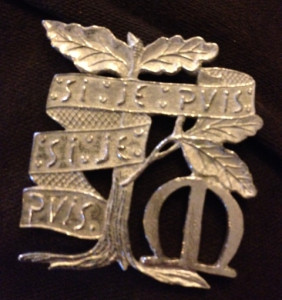
Si je puis – ‘If I can’, or, paraphrased by Rossetti ‘as I can’t’.
Many thanks to Red House and the people at Curiocity for creating such a challenging and enjoyable day out.
Vote for your favourite on #PRBday
September the 8th is PRB Day – your annual chance to vote for your favourite Pre-Raphaelite painting. This year is extra-special, being The Pre-Raphaelite Society’s 25th anniversary.
Founded in September 1988 (I was two!), the Society’s Review remains a great source of information and discussion – keeping the PRB as fresh and relevant as the day half a dozen boys got together in Millais’ living room and wondered if ‘brotherhood’ would make them sound like the clergy.
Last year, I voted for the 1860 Regina Cordium. I love the way Lizzie’s red beads cascade over her sickly green flesh; the queen of hearts languishing in a respiratory clinic.
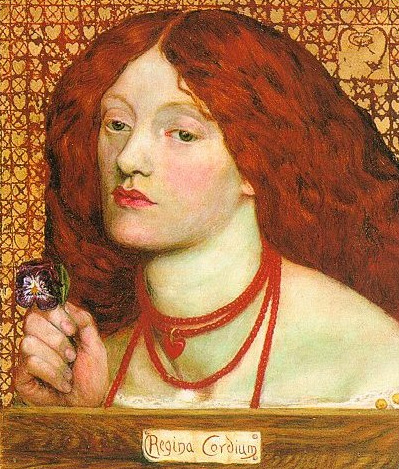
Tweet @PreRaphSoc with the hashtag #PRBDay and vote for your favourite Pre-Raphaelite painting. Last year’s winner was Millais’ Ophelia, but I think we can do better than that, don’t you? (Child genius = basically cheating, right?)

